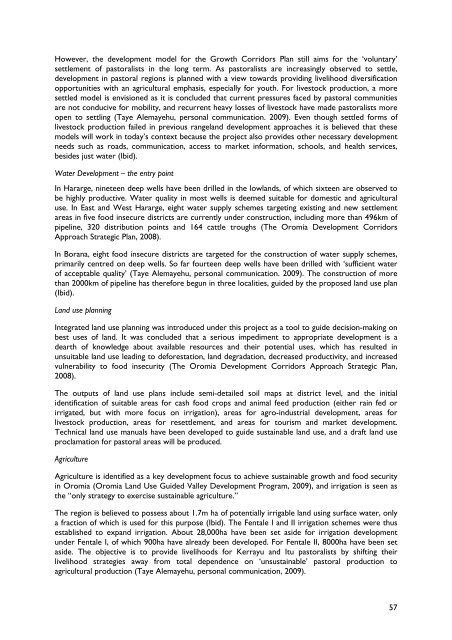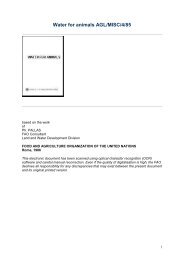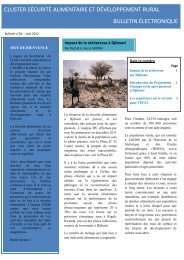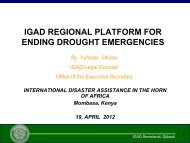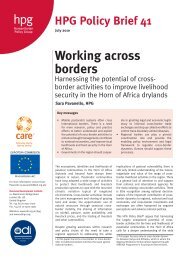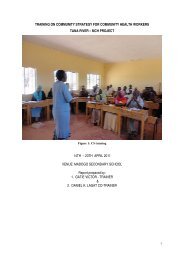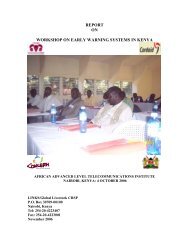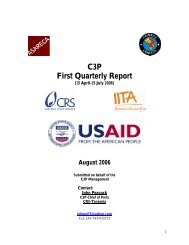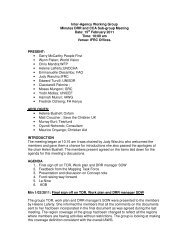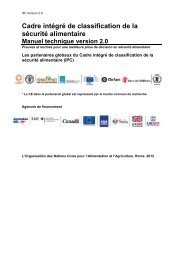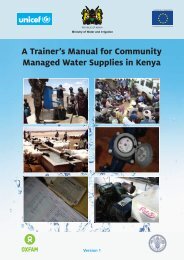sharing <strong>on</strong> water development best practice is critical to inform ways forward, <str<strong>on</strong>g>and</str<strong>on</strong>g> debate <str<strong>on</strong>g>and</str<strong>on</strong>g>dialogue <strong>on</strong> current practice is needed.Oromia Growth Corridors Plan 35The 5 year Oromia Growth Corridors Plan was prepared in 2006 by Oromia regi<strong>on</strong>al governmentin resp<strong>on</strong>se to what was seen as a failure <str<strong>on</strong>g>of</str<strong>on</strong>g> previous development efforts to bring sustainablesoluti<strong>on</strong>s to existing challenges in <strong>the</strong> lowl<str<strong>on</strong>g>and</str<strong>on</strong>g>s. It was c<strong>on</strong>cluded that piecemeal development effortscould not bring about sustainable development or food security, <str<strong>on</strong>g>and</str<strong>on</strong>g> a holistic <str<strong>on</strong>g>and</str<strong>on</strong>g> c<strong>on</strong>certedregi<strong>on</strong>al development effort was needed to achieve this objective, by using water as an entry point.The plan foresees that c<strong>on</strong>structing deep wells tapping into ‘permanent’ groundwater, supported bysurface water harvesting, will make possible multiple l<str<strong>on</strong>g>and</str<strong>on</strong>g> uses including livestock producti<strong>on</strong> as wellas irrigati<strong>on</strong>. Detailed l<str<strong>on</strong>g>and</str<strong>on</strong>g> use planning - a tool used for <strong>the</strong> first time at government level to informdevelopment in <strong>the</strong> rangel<str<strong>on</strong>g>and</str<strong>on</strong>g>s - will inform types <str<strong>on</strong>g>of</str<strong>on</strong>g> l<str<strong>on</strong>g>and</str<strong>on</strong>g> uses suitable for different areas. Accordingto <strong>the</strong> Oromia Water Works Design <str<strong>on</strong>g>and</str<strong>on</strong>g> Supervisi<strong>on</strong> Enterprise, “with <strong>the</strong> perspective <str<strong>on</strong>g>of</str<strong>on</strong>g> <strong>the</strong> PRSPtowards achieving <strong>the</strong> MDGs <str<strong>on</strong>g>and</str<strong>on</strong>g> ensuring fur<strong>the</strong>r ec<strong>on</strong>omic growth, investing in waterinfrastructure is not a matter <str<strong>on</strong>g>of</str<strong>on</strong>g> fashi<strong>on</strong> or opti<strong>on</strong> but essential <str<strong>on</strong>g>and</str<strong>on</strong>g> inescapable.”The trigger for <strong>the</strong> Plan was to explore resettlement potential in <strong>the</strong> lowl<str<strong>on</strong>g>and</str<strong>on</strong>g>s to alleviate pressure<strong>on</strong> <strong>the</strong> degraded <str<strong>on</strong>g>and</str<strong>on</strong>g> dwindling l<str<strong>on</strong>g>and</str<strong>on</strong>g> resources <str<strong>on</strong>g>of</str<strong>on</strong>g> <strong>the</strong> highl<str<strong>on</strong>g>and</str<strong>on</strong>g>s. The visi<strong>on</strong> for <strong>the</strong> Growth CorridorsPlan is that food insecure areas in <strong>the</strong> lowl<str<strong>on</strong>g>and</str<strong>on</strong>g>s could be transformed into development centreswhich will relieve pressure <strong>on</strong> degraded resources in <strong>the</strong> highl<str<strong>on</strong>g>and</str<strong>on</strong>g>s. Three ‘development corridors,’including South East Oromia Development Corridor, Central Oromia Development Corridor(which c<strong>on</strong>sists <str<strong>on</strong>g>of</str<strong>on</strong>g> <strong>the</strong> Rift Valley <str<strong>on</strong>g>and</str<strong>on</strong>g> <strong>the</strong> central Oromia highl<str<strong>on</strong>g>and</str<strong>on</strong>g>s), <str<strong>on</strong>g>and</str<strong>on</strong>g> <strong>the</strong> Western OromiaDevelopment Corridor are targeted. The Plan would ensure “equity <str<strong>on</strong>g>and</str<strong>on</strong>g> balanced development”(The Oromia Development Corridors Approach Strategic Plan, 2008 36 : 2) in <strong>the</strong>se regi<strong>on</strong>s.The Plan focuses <strong>on</strong> integrated development in <strong>the</strong> regi<strong>on</strong>, to include: 1) good governance, 2)effective <str<strong>on</strong>g>and</str<strong>on</strong>g> sustainable l<str<strong>on</strong>g>and</str<strong>on</strong>g> use <str<strong>on</strong>g>and</str<strong>on</strong>g> management systems, 3) human <str<strong>on</strong>g>and</str<strong>on</strong>g> livestock health, 3)infrastructure development (roads, power, communicati<strong>on</strong>, health <str<strong>on</strong>g>and</str<strong>on</strong>g> access to markets), 4)improved productivity <str<strong>on</strong>g>of</str<strong>on</strong>g> livestock <str<strong>on</strong>g>and</str<strong>on</strong>g> dryl<str<strong>on</strong>g>and</str<strong>on</strong>g> farming, 5) streng<strong>the</strong>ned implementati<strong>on</strong> capacity atlocal level (Ibid: 6).The multi-sectoral approachL<str<strong>on</strong>g>and</str<strong>on</strong>g> use plans are prepared in an integrated manner “incorporating all essential aspects <str<strong>on</strong>g>of</str<strong>on</strong>g>development” (Taye Alemayahu, pers<strong>on</strong>al communicati<strong>on</strong>, 2009) <str<strong>on</strong>g>and</str<strong>on</strong>g> with input from all sectors.Because it is multi-sectoral, implementati<strong>on</strong> <str<strong>on</strong>g>of</str<strong>on</strong>g> <strong>the</strong> plan is bey<strong>on</strong>d <strong>the</strong> scope or capabilities <str<strong>on</strong>g>of</str<strong>on</strong>g> any <strong>on</strong>eregi<strong>on</strong>al bureau. Thus <strong>the</strong> Oromia L<str<strong>on</strong>g>and</str<strong>on</strong>g> Administrati<strong>on</strong> <str<strong>on</strong>g>and</str<strong>on</strong>g> Envir<strong>on</strong>mental Protecti<strong>on</strong> Bureau wasestablished to guide <strong>the</strong> implementati<strong>on</strong> <str<strong>on</strong>g>of</str<strong>on</strong>g> <strong>the</strong> plan <str<strong>on</strong>g>and</str<strong>on</strong>g> to draft regulati<strong>on</strong>s regarding l<str<strong>on</strong>g>and</str<strong>on</strong>g> use - withbackstopping from <strong>the</strong> Oromia Water Works Design <str<strong>on</strong>g>and</str<strong>on</strong>g> Supervisi<strong>on</strong> Enterprise.The Deputy General Manager <str<strong>on</strong>g>of</str<strong>on</strong>g> <strong>the</strong> Oromia Water Works Design <str<strong>on</strong>g>and</str<strong>on</strong>g> Supervisi<strong>on</strong> Enterprise, TayeAlemayehu, believes that <strong>the</strong> multi-sectoral approach is what sets this program apart from earlyrangel<str<strong>on</strong>g>and</str<strong>on</strong>g> development projects such as <strong>the</strong> RDP. The premise is that covering <strong>the</strong> multipledevelopment needs in <strong>the</strong> rangel<str<strong>on</strong>g>and</str<strong>on</strong>g>s (including human <str<strong>on</strong>g>and</str<strong>on</strong>g> livestock health, infrastructure, etc.) mustgo h<str<strong>on</strong>g>and</str<strong>on</strong>g> in h<str<strong>on</strong>g>and</str<strong>on</strong>g> with availing water. He also notes that different l<str<strong>on</strong>g>and</str<strong>on</strong>g> use needs in <strong>the</strong> regi<strong>on</strong> arerecognized <str<strong>on</strong>g>and</str<strong>on</strong>g> c<strong>on</strong>sidered, made possible through detailed l<str<strong>on</strong>g>and</str<strong>on</strong>g> use planning, <str<strong>on</strong>g>and</str<strong>on</strong>g> that communityparticipati<strong>on</strong> plays a much more central role.35 This initiative is <strong>the</strong> <strong>on</strong>ly excepti<strong>on</strong> to <strong>the</strong> federal level projects highlighted so far, as it has been planned <str<strong>on</strong>g>and</str<strong>on</strong>g>is being implemented at regi<strong>on</strong>al level in Oromia regi<strong>on</strong>al state <strong>on</strong>ly (so far).36 This document is <strong>the</strong> master strategic plan guiding <strong>the</strong> initiative. All o<strong>the</strong>r documents cited in <strong>the</strong>descripti<strong>on</strong> <str<strong>on</strong>g>of</str<strong>on</strong>g> this initiative fall under <strong>the</strong> umbrella <str<strong>on</strong>g>of</str<strong>on</strong>g> this master strategic plan.56
However, <strong>the</strong> development model for <strong>the</strong> Growth Corridors Plan still aims for <strong>the</strong> ‘voluntary’settlement <str<strong>on</strong>g>of</str<strong>on</strong>g> pastoralists in <strong>the</strong> l<strong>on</strong>g term. As pastoralists are increasingly observed to settle,development in pastoral regi<strong>on</strong>s is planned with a view towards providing livelihood diversificati<strong>on</strong>opportunities with an agricultural emphasis, especially for youth. For livestock producti<strong>on</strong>, a moresettled model is envisi<strong>on</strong>ed as it is c<strong>on</strong>cluded that current pressures faced by pastoral communitiesare not c<strong>on</strong>ducive for mobility, <str<strong>on</strong>g>and</str<strong>on</strong>g> recurrent heavy losses <str<strong>on</strong>g>of</str<strong>on</strong>g> livestock have made pastoralists moreopen to settling (Taye Alemayehu, pers<strong>on</strong>al communicati<strong>on</strong>. 2009). Even though settled forms <str<strong>on</strong>g>of</str<strong>on</strong>g>livestock producti<strong>on</strong> failed in previous rangel<str<strong>on</strong>g>and</str<strong>on</strong>g> development approaches it is believed that <strong>the</strong>semodels will work in today’s c<strong>on</strong>text because <strong>the</strong> project also provides o<strong>the</strong>r necessary developmentneeds such as roads, communicati<strong>on</strong>, access to market informati<strong>on</strong>, schools, <str<strong>on</strong>g>and</str<strong>on</strong>g> health services,besides just water (Ibid).Water Development – <strong>the</strong> entry pointIn Hararge, nineteen deep wells have been drilled in <strong>the</strong> lowl<str<strong>on</strong>g>and</str<strong>on</strong>g>s, <str<strong>on</strong>g>of</str<strong>on</strong>g> which sixteen are observed tobe highly productive. Water quality in most wells is deemed suitable for domestic <str<strong>on</strong>g>and</str<strong>on</strong>g> agriculturaluse. In East <str<strong>on</strong>g>and</str<strong>on</strong>g> West Hararge, eight water supply schemes targeting existing <str<strong>on</strong>g>and</str<strong>on</strong>g> new settlementareas in five food insecure districts are currently under c<strong>on</strong>structi<strong>on</strong>, including more than 496km <str<strong>on</strong>g>of</str<strong>on</strong>g>pipeline, 320 distributi<strong>on</strong> points <str<strong>on</strong>g>and</str<strong>on</strong>g> 164 cattle troughs (The Oromia Development CorridorsApproach Strategic Plan, 2008).In Borana, eight food insecure districts are targeted for <strong>the</strong> c<strong>on</strong>structi<strong>on</strong> <str<strong>on</strong>g>of</str<strong>on</strong>g> water supply schemes,primarily centred <strong>on</strong> deep wells. So far fourteen deep wells have been drilled with ‘sufficient water<str<strong>on</strong>g>of</str<strong>on</strong>g> acceptable quality’ (Taye Alemayehu, pers<strong>on</strong>al communicati<strong>on</strong>. 2009). The c<strong>on</strong>structi<strong>on</strong> <str<strong>on</strong>g>of</str<strong>on</strong>g> morethan 2000km <str<strong>on</strong>g>of</str<strong>on</strong>g> pipeline has <strong>the</strong>refore begun in three localities, guided by <strong>the</strong> proposed l<str<strong>on</strong>g>and</str<strong>on</strong>g> use plan(Ibid).L<str<strong>on</strong>g>and</str<strong>on</strong>g> use planningIntegrated l<str<strong>on</strong>g>and</str<strong>on</strong>g> use planning was introduced under this project as a tool to guide decisi<strong>on</strong>-making <strong>on</strong>best uses <str<strong>on</strong>g>of</str<strong>on</strong>g> l<str<strong>on</strong>g>and</str<strong>on</strong>g>. It was c<strong>on</strong>cluded that a serious impediment to appropriate development is adearth <str<strong>on</strong>g>of</str<strong>on</strong>g> knowledge about available resources <str<strong>on</strong>g>and</str<strong>on</strong>g> <strong>the</strong>ir potential uses, which has resulted inunsuitable l<str<strong>on</strong>g>and</str<strong>on</strong>g> use leading to deforestati<strong>on</strong>, l<str<strong>on</strong>g>and</str<strong>on</strong>g> degradati<strong>on</strong>, decreased productivity, <str<strong>on</strong>g>and</str<strong>on</strong>g> increasedvulnerability to food insecurity (The Oromia Development Corridors Approach Strategic Plan,2008).The outputs <str<strong>on</strong>g>of</str<strong>on</strong>g> l<str<strong>on</strong>g>and</str<strong>on</strong>g> use plans include semi-detailed soil maps at district level, <str<strong>on</strong>g>and</str<strong>on</strong>g> <strong>the</strong> initialidentificati<strong>on</strong> <str<strong>on</strong>g>of</str<strong>on</strong>g> suitable areas for cash food crops <str<strong>on</strong>g>and</str<strong>on</strong>g> animal feed producti<strong>on</strong> (ei<strong>the</strong>r rain fed orirrigated, but with more focus <strong>on</strong> irrigati<strong>on</strong>), areas for agro-industrial development, areas forlivestock producti<strong>on</strong>, areas for resettlement, <str<strong>on</strong>g>and</str<strong>on</strong>g> areas for tourism <str<strong>on</strong>g>and</str<strong>on</strong>g> market development.Technical l<str<strong>on</strong>g>and</str<strong>on</strong>g> use manuals have been developed to guide sustainable l<str<strong>on</strong>g>and</str<strong>on</strong>g> use, <str<strong>on</strong>g>and</str<strong>on</strong>g> a draft l<str<strong>on</strong>g>and</str<strong>on</strong>g> useproclamati<strong>on</strong> for pastoral areas will be produced.AgricultureAgriculture is identified as a key development focus to achieve sustainable growth <str<strong>on</strong>g>and</str<strong>on</strong>g> food securityin Oromia (Oromia L<str<strong>on</strong>g>and</str<strong>on</strong>g> Use Guided Valley Development Program, 2009), <str<strong>on</strong>g>and</str<strong>on</strong>g> irrigati<strong>on</strong> is seen as<strong>the</strong> “<strong>on</strong>ly strategy to exercise sustainable agriculture.”The regi<strong>on</strong> is believed to possess about 1.7m ha <str<strong>on</strong>g>of</str<strong>on</strong>g> potentially irrigable l<str<strong>on</strong>g>and</str<strong>on</strong>g> using surface water, <strong>on</strong>lya fracti<strong>on</strong> <str<strong>on</strong>g>of</str<strong>on</strong>g> which is used for this purpose (Ibid). The Fentale I <str<strong>on</strong>g>and</str<strong>on</strong>g> II irrigati<strong>on</strong> schemes were thusestablished to exp<str<strong>on</strong>g>and</str<strong>on</strong>g> irrigati<strong>on</strong>. About 28,000ha have been set aside for irrigati<strong>on</strong> developmentunder Fentale I, <str<strong>on</strong>g>of</str<strong>on</strong>g> which 900ha have already been developed. For Fentale II, 8000ha have been setaside. The objective is to provide livelihoods for Kerrayu <str<strong>on</strong>g>and</str<strong>on</strong>g> Itu pastoralists by shifting <strong>the</strong>irlivelihood strategies away from total dependence <strong>on</strong> ‘unsustainable’ pastoral producti<strong>on</strong> toagricultural producti<strong>on</strong> (Taye Alemayehu, pers<strong>on</strong>al communicati<strong>on</strong>, 2009).57
- Page 1 and 2:
Synthesis
- Page 4 and 5:
TABLE OF CONTENTSLIST OF ACRONYMS..
- Page 6 and 7: ACKNOWLEDGMENTSI would like to exte
- Page 8 and 9: LIST OF ACRONYMSACDI/VOCAACFAFDCDDC
- Page 10 and 11: EXECUTIVE SUMMARYWater development
- Page 12 and 13: understanding <str
- Page 14 and 15: Agreed upon guidelines for water de
- Page 16 and 17: • Make better use of</str
- Page 18 and 19: to inform their own work an
- Page 20 and 21: Within pastoral areas, it is recogn
- Page 23 and 24: Section 2. Overview of</str
- Page 25 and 26: Dohrn, 2006). Spatially variable ra
- Page 27 and 28: The following broad overview touche
- Page 29 and 30: In areas of adequa
- Page 31 and 32: observed response was for individua
- Page 33 and 34: Specific to water development, seve
- Page 35 and 36: Section 3. Water development todayT
- Page 37 and 38: Eliciting payments for water from l
- Page 39 and 40: ureaus 25 . The ministry’s interv
- Page 41 and 42: National policy paints a conflictin
- Page 43 and 44: will be given to pastoralists to en
- Page 45 and 46: Water supplyGovernance and<
- Page 47 and 48: vulnerable to conversion for other
- Page 49 and 50: • Agro-pastoralists’ priorities
- Page 51 and 52: Although the WSDP principles are se
- Page 53 and 54: The Universal Access ProgramThe Uni
- Page 55: • Help ensure that public works d
- Page 59 and 60: Figure 4: Proposed pilot la
- Page 61 and 62: Many international and</str
- Page 63 and 64: Furthermore, attention is given to
- Page 65 and 66: CARE International, under the GWI,
- Page 67: and traditional me
- Page 70 and 71: • Understand exi
- Page 72 and 73: 4.2 Key observations in the water d
- Page 74 and 75: epresent a firm attempt to preserve
- Page 76 and 77: learning from NGO experiences in Bo
- Page 78 and 79: However, there are currently no spe
- Page 80 and 81: 4.3 Conclusion, ways forward <stron
- Page 82 and 83: In sum, pastoralism as a livelihood
- Page 84 and 85: • Water interventions selected sh
- Page 86 and 87: • Promote effective participation
- Page 88 and 89: Gebre-Mariam, A. (1982). Organizati
- Page 90: Schimann P. and Ph


